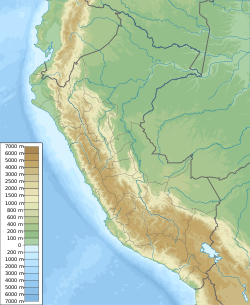
Back Мачу Пикчу Abkhazian Machu Picchu Afrikaans Machu Picchu GSW ማቹ ፒቹ Amharic ماتشو بيتشو Arabic ماتشو بيتشو ARZ Machu Picchu AST Machu Pikchu Aymara Maçu Piçu Azerbaijani Macchu Picchu BAN
Machu Pikchu | |
 Machu Picchu in 2023 | |
 Click on the map for a fullscreen view | |
| Alternative name | Machupicchu |
|---|---|
| Location | Machupicchu District, Urubamba, Cusco, Peru |
| Region | Andes |
| Coordinates | 13°09′48″S 72°32′44″W / 13.16333°S 72.54556°W |
| Altitude | 2,430 m (7,972 ft) |
| Type | Settlement |
| History | |
| Founded | c. 1450 – c. 1470[1] |
| Abandoned | c. 1532 – c. 1565[2][3] |
| Cultures | Inca civilization |
| Site notes | |
| Discovered | Agustín Lizárraga (1902) Hiram Bingham (1911) |
| Condition | Preserved |
| Ownership | Peruvian Government |
| Management | Peruvian Ministry of Culture |
| Public access | Yes |
| Website | machupicchu.gob.pe |
| Official name | Historic Sanctuary of Machu Picchu |
| Location | Latin America and the Caribbean |
| Criteria | Mixed: i, iii, vii, ix |
| Reference | 274 |
| Inscription | 1983 (7th Session) |
| Area | 38,160.87 ha (94,297.6 acres) |
Machu Picchu[a] is a 15th-century Inca citadel located in the Eastern Cordillera of southern Peru on a mountain ridge at 2,430 meters (7,970 ft). It is situated in the Machupicchu District of Urubamba Province[9] about 80 kilometers (50 mi) northwest of Cusco, above the Sacred Valley and along the Urubamba River, which forms a deep canyon with a subtropical mountain climate.[10]
Often referred to as the "Lost City of the Incas",[11] Machu Picchu is one of the most iconic symbols of the Inca civilization and a major archaeological site in the Americas. Built around 1450, it is believed to have served as an estate for the Inca emperor Pachacuti, though no contemporary written records exist to confirm this. The site was abandoned roughly a century later, likely during the Spanish conquest. Modern radiocarbon dating places its occupation between c. 1420 and 1530.[12]
Machu Picchu was constructed in the classical Inca style, featuring finely crafted dry-stone walls. Notable structures include the Temple of the Sun, the Temple of the Three Windows, and the Intihuatana ritual stone. Although known locally, it was brought to international attention in 1911 by American historian Hiram Bingham III. Earlier visitors, including the Peruvian explorer Agustín Lizárraga, had reached the site in the early 20th century. Recent research published in 2022 suggests that the original Inca name of the site may have been Huayna Picchu, after the mountain on which part of the complex stands.[13]
Designated a National Historic Sanctuary by Peru in 1981 and a UNESCO World Heritage Site in 1983, Machu Picchu was also named one of the New Seven Wonders of the World in 2007.[14] As of 2024[update], the site receives over 1.5 million visitors annually, making it Peru’s most visited international tourist destination.
- ^ Burger & Salazar 2004, p. 27.
- ^ Burger & Salazar 2004, p. 209.
- ^ Lumbreras 2020b, pp. 193–232.
- ^ "Machu Picchu". Lexico UK English Dictionary. Oxford University Press. Archived from the original on 28 January 2021.
- ^ a b "Machu Picchu". Merriam-Webster.com Dictionary. Merriam-Webster.
- ^ "How to say: Machu Picchu". BBC Blogs. BBC. 8 September 2006. Retrieved 12 August 2024.
- ^ "Machu Picchu se escribe con doble «c» en «Picchu»". FundéuRAE. August 2022. Retrieved 17 August 2024.
- ^ Rufino, Alosilla & Choque 2014, p. 70.
- ^ "Historic Sanctuary of Machupicchu". National Service of Natural Protected Areas. 21 January 2022. Archived from the original on 13 June 2025. Retrieved 12 August 2024.
- ^ Spizzichino et al. 2022, pp. 16–19.
- ^ Hearn, Kelly; Golomb, Jason (21 January 2017). "Machu Picchu". National Geographic. Retrieved 12 August 2024.
- ^ Burger et al. 2021.
- ^ Amado Gonzales & Bauer 2022.
- ^ "New Seven Wonders of the World chosen". NBC News. Associated Press. 7 July 2007. Retrieved 24 July 2025.
Cite error: There are <ref group=lower-alpha> tags or {{efn}} templates on this page, but the references will not show without a {{reflist|group=lower-alpha}} template or {{notelist}} template (see the help page).

